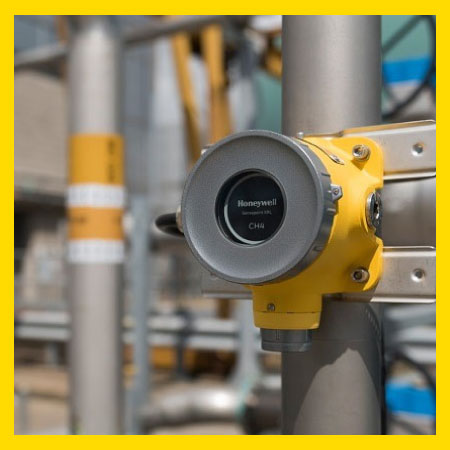Currency
November 08, 2022

lammable gas leaks continue to pose a real threat to workers and assets across the process industry. Gas and flame detection provide an early warning against this risk. But no single detection technology alone is 100 percent effective, which is where a layered approach comes in. By integrating the following four layers of protection, you can minimize the risk of flammable gas leaks going undetected.
Detecting a gas leak early is key to preventing major disruption to plant operations. This is where ultrasonic gas detection technology is superior. This technology can ‘hear’ the ultrasounds emitted by escaping gas at the speed of sound. Even a small and low-pressure leak within a 20 m range* can be identified, buying you critical time to respond.

However, ultrasonic detection alone isn’t enough. Only pressurized gas can cause an ultrasonic detector to activate, meaning non-pressurized leaks will never be heard. Interference from other ultrasonic noise sources present in the application can be louder than a small leak. Finally, ultrasonic gas leak detection will alert you to a leak but won’t provide any indication of the gas type or concentration.
Open path infrared (IR) detection offers an extra layer of protection against flammable gases that may not have been heard by the ultrasonic layer. It can detect flammable hydrocarbons up to a 330 meter range, even at low concentrations, greatly increasing the chances of finding a leak. Unlike ultrasonic detection, it also provides critical data on threat levels based on gas concentration/size, enabling you to make informed decisions.
But even open path IR detection isn’t a one-size-fits-all solution. Since the gas must physically pass between the transmitter/receiver pair to activate an alarm, gas leaks may go undetected under windy conditions. Open path IR is also unsuitable for confined spaces.
Point IR detection is often the basic option when it comes to flammable gas monitoring. Unlike open path IR, it can be deployed in small areas and confined spaces, especially near potential leak sources such as valves, flanges, and pumps, offering a basic layer of protection. A key advantage of deploying point detectors is that they measure actual gas concentrations at a point in space and time. By installing multiple devices, you can gain an accurate map of a gas release event.
Detecting a gas leak early is key to preventing major disruption to plant operations. This is where ultrasonic gas detection technology is superior. This technology can ‘hear’ the ultrasounds emitted by escaping gas at the speed of sound. Even a small and low-pressure leak within a 20 m range* can be identified, buying you critical time to respond.

However, ultrasonic detection alone isn’t enough. Only pressurized gas can cause an ultrasonic detector to activate, meaning non-pressurized leaks will never be heard. Interference from other ultrasonic noise sources present in the application can be louder than a small leak. Finally, ultrasonic gas leak detection will alert you to a leak but won’t provide any indication of the gas type or concentration.
Open path infrared (IR) detection offers an extra layer of protection against flammable gases that may not have been heard by the ultrasonic layer. It can detect flammable hydrocarbons up to a 330 meter range, even at low concentrations, greatly increasing the chances of finding a leak. Unlike ultrasonic detection, it also provides critical data on threat levels based on gas concentration/size, enabling you to make informed decisions.
But even open path IR detection isn’t a one-size-fits-all solution. Since the gas must physically pass between the transmitter/receiver pair to activate an alarm, gas leaks may go undetected under windy conditions. Open path IR is also unsuitable for confined spaces.
Point IR detection is often the basic option when it comes to flammable gas monitoring. Unlike open path IR, it can be deployed in small areas and confined spaces, especially near potential leak sources such as valves, flanges, and pumps, offering a basic layer of protection. A key advantage of deploying point detectors is that they measure actual gas concentrations at a point in space and time. By installing multiple devices, you can gain an accurate map of a gas release event.









